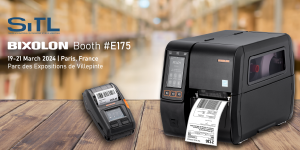Thermal printing may seem a thing of the past for many who have become accustomed with laser and inkjet printers in recent years. Thermal printers do, however, continue to be used by many sizeable operations within both the manufacturing and logistics sector. This is partly due to the low initial investment and little ongoing maintenance they require.
As a leading manufacturer of both thermal transfer and direct thermal printers, BIXOLON works with organisations around the globe to find the perfect solution for them, whether it be for simple barcoding, compliance labelling or small parts tracking. However, many organisations still turn to expensive and high maintenance printing solutions due to them knowing little about thermal alternatives and the benefits they can offer.
In this article, we’ll delve into the technicalities of thermal printing and what separates it from alternative solutions. We’ll also explore what you should look for when shopping for a printer, whatever your budget and requirements.
What is Thermal Printing and How Does It Work?

The first of these components in a thermal head, which is the primary component for generating heat and produces the image on the thermal paper as it passes over. The thermal head selectively heats areas of the paper, dependent upon what has been inputted into the printer, and turns the special coating located on the thermal paper black. When a printer supports additional colours, such as red, the thermal head will produce two different temperatures to determine which areas of the image are black and which are coloured.
For the thermal head to make contact with the thermal paper, a spring is required. This component is simple in nature and ensures that the thermal head sits appropriately on the paper to create a clear image without any severe damage being caused to the paper.
Another important component within any thermal printer is the platen, a rubber roller that feeds paper into the device itself. This platen is like that found on most laser printers and ensures that the paper is feed into the printer straight and therefore produces a high-quality and straight print.
Finally, for each of the previously listed components to work in synergy a controller board is necessary. It is this board, which works similarly to a computers mother board, that provides the user interface displayed on the printers’ screen, manoeuvres the various components and warns of any issues.
Which Thermal Printing Solution is Right for You?
The thermal printing market is one of huge variety. In fact, BIXOLON alone manufacture and sell a wide collection of thermal transfer and direct thermal printers. Each of these printers are designed for different uses and offer varied levels of technical capabilities.

The BIXOLON DLP-T400 printer, for example, is ideal for those in search of a simple yet reliable desktop printer for barcode, QR and labelling requirements. Our SLP-TX400, on the other hand, features our Smart Media Detection technology. This helps detect the media being used and alter the printing accordingly.
For most organisations the most important consideration is the compatibility a chosen printer provides and the wired connections it offers. This is as a lack of WLAN connectivity could be the difference between your printer working with your existing system or not. Finally, selecting a thermal printer ensuring that it works with the various programming languages, including SLCS, is wise.
If you have more questions or are struggling to find a printing solution for you, contact BIXOLON. You can contact us online or call +49-211-68-78-54-0.
Advantages of Thermal Printers:
- Speed: Thermal printers are very fast. They can print up to 8 inches per second, which is much faster than inkjet or dot-matrix printers. This makes them ideal for situations where speed is a critical factor, such as printing shipping labels or receipts.
- Low Cost: Thermal printers are inexpensive compared to other types of printers. They do not require ink or toner, which means there are no ongoing costs associated with using them. This makes them a cost-effective solution for businesses that need to print large volumes of labels or receipts.
- High Quality: Thermal printers produce high-quality prints. The prints are sharp and clear, with no smudging or blurring. This makes them ideal for printing barcodes, shipping labels, and other documents that need to be easy to read and scan.
- Durable: Thermal prints are durable and can withstand harsh environments. They do not fade or smear when exposed to sunlight or moisture, making them ideal for outdoor use. This is especially useful in industries such as logistics and manufacturing, where labels and tags need to withstand tough conditions.
- Low Maintenance: Thermal printers require minimal maintenance. They do not have any moving parts, which means they are less likely to break down or need repairs. This makes them a reliable choice for businesses that need a printer that can run continuously without interruptions.
Applications of Thermal Printers:
- Retail: Thermal printers are commonly used in retail environments to print receipts, shipping labels, and price tags. They are ideal for printing barcodes and other information that needs to be scanned quickly and accurately. They are also used to print labels for products, making it easier to track inventory and manage stock levels.
- Healthcare: Thermal printers are used extensively in healthcare settings. They are used to print patient wristbands, labels for medications, and other important documents. They are also used to print labels for medical equipment, making it easier to track and manage inventory.
- Logistics: Thermal printers are essential in logistics and shipping industries. They are used to print shipping labels, packing slips, and other important documents. They are also used to print barcodes for tracking packages and shipments, making it easier to manage logistics and track inventory.
- Manufacturing: Thermal printers are commonly used in manufacturing settings. They are used to print labels for products, making it easier to track inventory and manage stock levels. They are also used to print barcodes for tracking products and managing production processes.
- Hospitality: Thermal printers are used in the hospitality industry to print receipts, order tickets, and other important documents. They are also used to print labels for food and beverage items, making it easier to track inventory and manage stock levels
You can see our entire range of thermal printers here.




